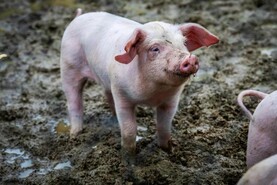There was the usual competition among retailers at the National Ploughing Championships this week, each trying to outdo the others by showing their commitment to Irish producers. Pictures of Irish suppliers were not only draped from the ceilings – as is now commonplace in their stores – we also had images of Irish produce along every available inch of the retailers’ marquees.
Few could dispute that displaying such images helps reinforce the high safety and environmental standards to which Irish food is produced. In this sense, we should welcome the retailers’ commitment to being present at the event and showcasing all that is good about our industry. However, where the misconception arises is that consumers walking out of retailer marquees could be forgiven for thinking that the retailer and farmer relationship is strong, fair and equitable. Nothing could be further from the truth. In many cases, it is the same food items used by retailers to promote their commitment to Irish farmers that are devalued simply to lure customers into their stores.
It is a well-rehearsed strategy where the margins on known value items (KVIs) such as bread, milk and meat are foregone only to be recouped from increased margins secured on the wider product offering available across the store. While retailer-processor contracts are seldom discussed in public, it is widely accepted that it is the processor, and ultimately the producer, that carries the costs of such promotional activity.
Poultry farmers are the latest to take the hit from such tactics. In recent weeks, we have seen competition among retailers force the price of a whole Irish chicken down to just €3. It sees an Irish chicken, produced to the highest standards in the world, priced at a similar level to a cup of coffee, tube of toothpaste or packet of chocolate bars.
The move to aggressively devalue consumer price expectations for chicken will have serious consequences, not only for poultry but the entire livestock sector. A sustained race to the bottom on the price of chicken will undoubtedly create product displacement and have a serious impact on consumer demand for beef, lamb and pork.
The decision to devalue meat protein comes at a time when poultry and pig farmers are struggling to stay in business and beef margins are wafer thin. This perhaps gives the best indication as to retailers’ true commitment to Irish farmers and to developing a sustainable supply chain.
Allowing the current model to prevail is not in the long-term interests of farmers or consumers. The €3 chicken is merely a marketing ploy to attract people into stores and expose them to other higher-margin products. Despite the level of destruction caused to the primary production base, the consumer gains little when assessed across their basket of goods.
Those engaged in the sector have seen through the empty commitments of retailers to deliver an equitable supply chain. We should see the retail sector for what it is: an industry driven by market share and short-term profits to deliver a return for their shareholder base.
Change will only come with the introduction of legislation at EU level that prevents retailers from abusing their buying power when dealing with a range of single product suppliers. Europe has talked around this problem for long enough. A supply chain where fresh food can be devalued by retailers to boost sales of higher-margin products is clearly dysfunctional and needs to be regulated.






 This is a subscriber-only article
This is a subscriber-only article










SHARING OPTIONS: